 January 2021
“But I know, somehow, that only when it is dark enough can you see the stars.”
― Martin Luther King, Jr.
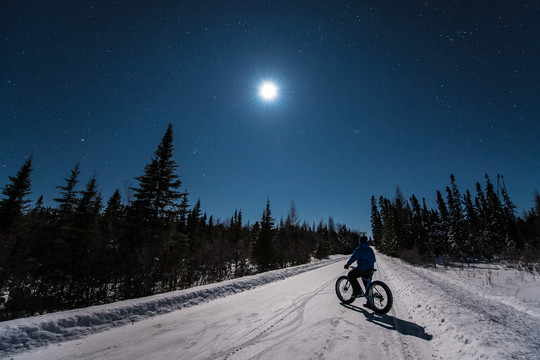 Fat biking in the Arrowhead region of the Northwoods under a full moon. PHOTO CREDIT: Travis Novitsky
With the winter solstice barely behind us, we have few daylight hours for outdoor activity. But what if we embrace the darkness and use it to our advantage?
Full moons on clear nights can be stunning and a good way to illuminate your way. Next full moon is Jan. 28. Carry a headlamp but be mindful of light pollution—the brighter your light, the less stars you and other hikers will see. Being able to stargaze before bedtime is one of the many appeals of winter hiking.
It can be intimidating to walk in the dark in an unknown area. If you let your eyes adjust to the darkness, you’ll see it’s not as dark. Keep an ear out for nocturnal creatures.
We invite you to embrace winter and its long nights, like our ancestors used to do. Celebrate the gifts of wonder and mystery the darkness brings.
Look for stars and the hope of a new year, and keep going outside to find much needed peace and quiet.
"Wanagi Tancanku" - Dakota for "road of the spirits"
(Milky Way)
 Wanagi Tancanku from Grand Portage. PHOTO CREDIT: Travis Novitsky
Ojibwe (Minnesota Chippewa Tribe): Like many events in American Indian culture there is a proper time and place for all activities. Traditional storytelling is reserved for the winter months for many tribes. This was a practical choice given the fact that during the other seasons, people were busy growing, gathering, and hunting food. It was in the winter, with the long dark evenings, the snow and wind blowing outside, that telling stories was a way to entertain and teach the children. Another reason is that many traditional stories contain animal characters. To be respectful, people waited until the winter when animals hibernate or become less active so they cannot hear themselves being talked about.
SOURCE: Indian Land Tenure Foundation/Lessons of Our Land
Assiniboine/Sioux (South Dakota): Waniyetu [winter]—time for gathering can'sa'sa [red willow bark] while the Thunder is gone.
Ho-Chunk Nation (Wisconsin): We have to wait for the Winter Moon, and there has to be snow on Mother Earth for those stories.
SOURCE: Smithsonianmag.com

Packing List
-
Flashlight/headlamp with a red light to reduce impact on night vision.
-
Clothing: Many layers and no cotton. Use synthetics or wool, instead, as they wick moisture. Mittens will keep you warmer as your fingers generate more heat if they are not separated.
-
Footwear: Winter boots or hiking boots with heavy socks, depending on the conditions. Ice cleats can help you with grip in icy conditions. Your shoes should be roomy. Tight shoes will cut circulation and make you cold.
-
Map: Know how to read it and know where you are at all times, even if you use a phone for navigation, as electronics can fail when it's cold.
- Have a cellphone for emergencies, but know you can’t always count on cell service. A battery pack could be useful to keep your phone charged.
-
Water: Stay hydrated to stay warm. Bring your own water, as most outdoors water spigots are shut down in the winter.
-
Food: Carry more than you think you’ll need. Make sure you have plenty of calories. If you’re going on a longer hike, having an emergency meal and a way to cook it is also prudent. Keep energy bars in your pockets close to your body to prevent them from freezing.
- An emergency blanket and first aid kit.
Safety Tips
- Whatever season you hike in, always tell someone where you’re going and when you expect to return.
-
Watch for icy sections: Do the "penguin walk," keeping your center of gravity on one leg, your knees loose, and extending your arms to the side to keep your balance.
-
Test your gear close to home.
- Start on a familiar trail and don't go alone. Take it slow, watch for trail markers and turns.
- If you don’t know the ice thickness, don’t venture on frozen bodies of water.
Minnesota state parks close at 10 p.m.
More winter recreation resources at mndnr.gov/WinterGuide
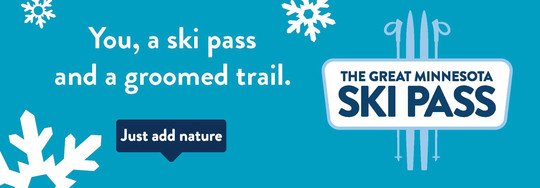

 Verify your location along the way so you know where you are at all times.
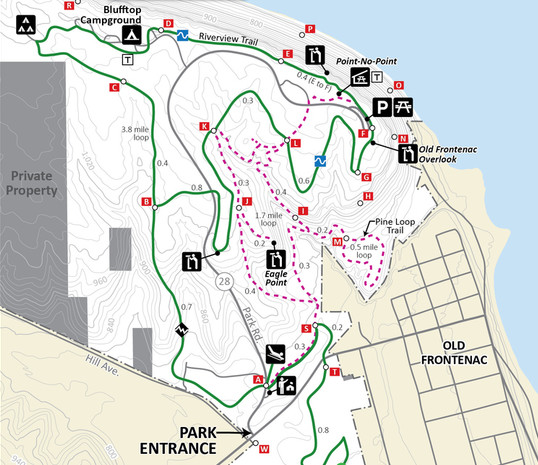 Winter maps, like this one for Frontenac State Park, can be found on each park's website.
Choose your adventure and the right trail for it.
Most state parks have winter maps to help you find groomed trails for cross country skiing and ungroomed trails for hiking or snowshoeing. Find the winter map on the state park's webpage.
Trails groomed for skiing are marked green on the map and have one of three symbols to indicate difficulty level (usually, indicative of how hilly they are.) Look for trail markers or directions along the way. You need the Great Minnesota Ski Pass to ski on these trails.
State trails are designated for multiple uses, all listed on our website. Plan ahead and check mndnr.gov/snow to see if the the trail you plan to use will be groomed for skiing or snowmobiling, depending on snow conditions.

If nothing else, we know one thing has changed with the new year: Your Minnesota state parks year-round permit sticker.
We commemorate 100 years of Scenic State Park featuring its most popular hike, Chase Point Trail, an esker-like trail covered in red pine and white cedar.
Plan ahead, and get it online before your next outing. Good Awesome for 12 months.

 Fox hunt most often during dusk and dawn and make a hair-raising scream when they are alarmed. PHOTO CREDIT: Travis Novitsky
What does the fox say?
Heightened senses are important in the dark. During a night outing, our sense of sight is reduced so we compensate by using hearing and touch. This is why nocturnal animals have highly developed senses of smell, hearing and eyesight.
Most wildlife make a variety of vocalizations to communicate, establish territories, find habitat, court and mate, raise families, find food, avoid predators and protect their young. So when your super-sense of hearing kicks in at night, listen for the calls of the wild.
Eastern cottontail rabbits are active at dusk and dawn. You may hear their squeal when they are distressed.
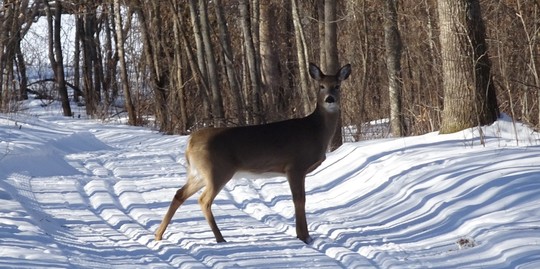 White-tailed deer make hundreds of vocalizations including snorts when nervous and bleats when scared. They are most active at dusk and dawn.
 Screech owl chicks. PHOTO COPYRIGHT: Carrol Henderson
The Eastern screech owl makes a territorial call that sounds like a tiny horse whinnying in the forest. Screech owls hunt most often during the first hours after darkness.
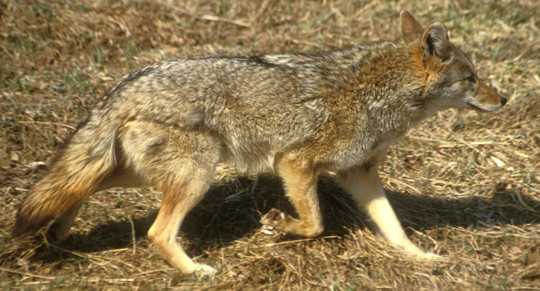 PHOTO COPYRIGHT: Carrol Henderson
Coyotes are most active at night and you can hear their gathering and territorial group calls throughout Minnesota.
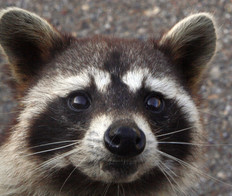
During warm winter evenings you may hear raccoons scream as they fight over food. They are most active after dark.
PHOTO: USFWS
|
Explore more animal sounds and learn about sound preservation efforts being led by the National Park Service.
 The fisher's fur changes with the season, with dense and glossy coats in winter, ranging in thickness from about 1 inch on the chest to 3 inches on the back. PHOTO CREDIT: Travis Novitsky

"Jiibayag niimi'idiwak" - Ojibwe for "the spirits are dancing"
(Northern Lights)
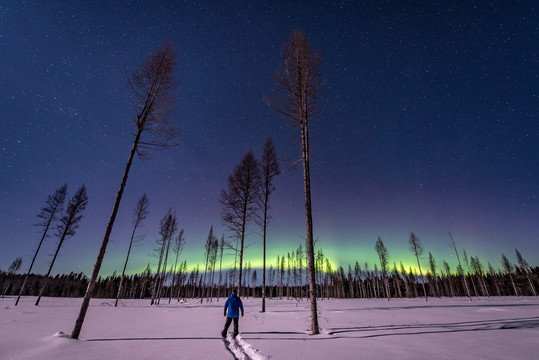 "A Head Full of Dreams." The Northern Lighs or Aurora Borealis discovered on a winter hike. PHOTO CREDIT: Travis Novitsky
Travis Novitsky, state park supervisor and member of the Grand Portage Band of Lake Superior Chippewa, spends his free time capturing breathtaking images of the night sky and wild creatures—which he graciously shares for the enjoyment of Trailblazer subscribers!
 The faces and stories of our visitors and staff.
"La blancura del invierno tiene una sensación de tranquilidad y aire fresco. La adrenalina al escalar hielo es sensacional. El sonido de contacto que hacen los picos y crampones con el hielo es increíble. Cuando voy subiendo poco a poco, siento como que estoy completando un rompecabezas para llegar lo más alto posible."
~Cecilia Howard

Though hailing from El Salvador, a Central American country much closer to the Equator than Minnesota, Cecilia Howard is not one to hang her climbing harness once temperatures dip below freezing. Instead, she takes out the crampons and ice axes and travels vertically up ice walls.
"The whiteness of winter gives a feeling of calm and fresh air," explains Cecilia. She loves the adrenaline when climbing ice. "The sound of the crampons and axes hitting the ice is incredible. Getting to the top after climbing up little by little is like completing a puzzle."
An avid outdoorswoman, Ceci is outside year- round hiking, climbing, whitewater rafting, and log rolling. She enjoys the workout as much as the beautiful outdoor places in Minnesota.
|
Above photo, selfie of Cecilia ice climbing near Sandstone, MN.
|